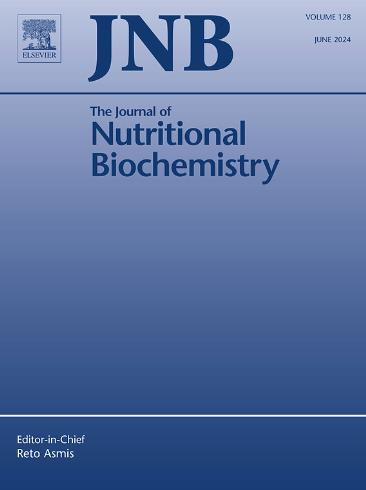Microbial–purine metabolic crosstalk regulates colitis-related intestinal fibrosis: A multiomics and cohort analysis approach
IF 4.8
2区 医学
Q1 BIOCHEMISTRY & MOLECULAR BIOLOGY
引用次数: 0
Abstract
Intestinal fibrosis (IF) is a severe complication of inflammatory bowel disease (IBD), often requiring surgical interventions. The modulating role of the microbial-metabolic link in IF remains unclear. We aimed to identify disturbances in microbiome–metabolome interactions during IF progression and recognize potential metabolic biomarkers. Compositional and functional signatures, along with murine IF progression, were determined through 16S rRNA sequencing and widely targeted metabolomics. Overall, 109 patients with IBD and 111 healthy controls (HCs) were enrolled and clinically evaluated. Correlations analyses were performed to reveal the relationship between microbial–purine metabolic alterations and disease markers. Gut microbiome analysis identified structural disruptions, including a reduction in uric acid (UA)-decomposed microbes and an increase in hyperuricemia-associated taxa (P<.05), which contributed to impaired purine metabolism (P<.05). Metabolomic profiling further indicated reprogramming of purine metabolism in fibrogenesis, as evidenced by elevated UA levels in fecal, colonic, and serum samples that correlated with inflammatory and fibrotic markers. In IBD patients, compared to HCs, serum UA (342.55±95.69 vs. 294.78±66.58 µmol/L) and UA/creatinine (UA/Cr) levels (5.17±1.57 vs. 4.40±1.28) were greatly increased (P<.001) and positively correlated with the clinical and endoscopic activities, especially in CD patients. Serial measurements demonstrated elevated UA during stenosis formation. UA/Cr may be an independent risk factor (P=.006) for stenosis prognosis. Abnormal purine metabolism may regulate IF, as reflected in purine metabolism-related microbes and metabolites. Elevated serum UA and UA/Cr levels are promising biomarkers for detecting disease activity and predicting stenosis in IBD.

微生物-嘌呤代谢串扰调节结肠炎相关肠道纤维化:多组学和队列分析方法
肠纤维化(IF)是炎症性肠病(IBD)的严重并发症,通常需要手术干预。微生物代谢联系在IF中的调节作用尚不清楚。我们的目的是确定IF进展过程中微生物组-代谢组相互作用的干扰,并识别潜在的代谢生物标志物。方法:通过16S rRNA测序和广泛靶向代谢组学来确定小鼠IF进展的组成和功能特征。总的来说,109名IBD患者和111名健康对照(hc)被纳入并进行了临床评估。进行相关性分析以揭示微生物嘌呤代谢改变与疾病标志物之间的关系。结果:肠道微生物组分析发现结构破坏,包括尿酸(UA)分解微生物减少和高尿酸血症相关分类群增加(P < 0.05),这导致嘌呤代谢受损(P < 0.05)。代谢组学分析进一步表明,嘌呤代谢在纤维形成过程中发生了重编程,粪便、结肠和血清样本中与炎症和纤维化标志物相关的UA水平升高证明了这一点。与hc相比,IBD患者血清UA(342.55±95.69 vs 294.78±66.58 μmol/L)和UA/肌酐(UA/Cr)水平(5.17±1.57 vs 4.40±1.28)显著升高(P < 0.001),且与临床和内镜活动呈正相关,尤其是CD患者。连续测量显示狭窄形成期间UA升高。UA/Cr可能是狭窄预后的独立危险因素(P = 0.006)。结论:嘌呤代谢异常可能调控IF,反映在嘌呤代谢相关微生物和代谢物上。升高的血清UA和UA/Cr水平是检测疾病活动性和预测IBD狭窄的有希望的生物标志物。
本文章由计算机程序翻译,如有差异,请以英文原文为准。
求助全文
约1分钟内获得全文
求助全文
来源期刊

Journal of Nutritional Biochemistry
医学-生化与分子生物学
CiteScore
9.50
自引率
3.60%
发文量
237
审稿时长
68 days
期刊介绍:
Devoted to advancements in nutritional sciences, The Journal of Nutritional Biochemistry presents experimental nutrition research as it relates to: biochemistry, molecular biology, toxicology, or physiology.
Rigorous reviews by an international editorial board of distinguished scientists ensure publication of the most current and key research being conducted in nutrition at the cellular, animal and human level. In addition to its monthly features of critical reviews and research articles, The Journal of Nutritional Biochemistry also periodically publishes emerging issues, experimental methods, and other types of articles.
 求助内容:
求助内容: 应助结果提醒方式:
应助结果提醒方式:


